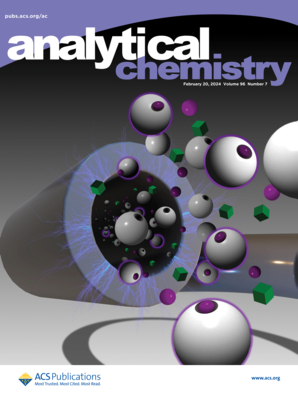Enabling Sensitive Quantification of Exosomes Combining Aptamer-Based Rolling Circle Amplification and Silver Nanoparticles
IF 6.7
1区 化学
Q1 CHEMISTRY, ANALYTICAL
引用次数: 0
Abstract
Exosomes carry various biological information and are abundant in body fluids, making them a promising noninvasive biomarker for disease diagnosis and prognosis. However, current detection methods have limitations in sensitivity, specificity, and cost effectiveness, hindering their clinical application. To address these challenges, we have developed a fast, accurate, and cost-effective method for detecting exosomes with high sensitivity and specificity, making it ideal for clinical applications. Clusters of differentiation 63 (CD63) aptamer with its complementary DNA (CD63 aptamer/cDNA) linked to streptavidin-coated magnetic beads (SA-MBs) are used as a capture probe. Exosomes with CD63 proteins can bind to the aptamer and release the cDNA, which initiates rolling circle amplification (RCA) to magnify the cDNA copies. The negatively charged RCA products induce the aggregation of positively charged spermine-modified silver nanoparticles (AgNPs) through electrostatic attraction. The aggregation of AgNPs can be observed visually with the naked eye or quantitatively analyzed using ultraviolet–visible (UV–vis) spectroscopy to determine the concentration of exosomes, with limits of detection of 4.0 × 104 particles/mL for visual observation and 800 particles/mL for UV–vis spectroscopy, respectively. The method has also been demonstrated for detecting the exosomes in serum samples, indicating its potential for clinical use in liquid biopsy.

求助全文
约1分钟内获得全文
求助全文
来源期刊

Analytical Chemistry
化学-分析化学
CiteScore
12.10
自引率
12.20%
发文量
1949
审稿时长
1.4 months
期刊介绍:
Analytical Chemistry, a peer-reviewed research journal, focuses on disseminating new and original knowledge across all branches of analytical chemistry. Fundamental articles may explore general principles of chemical measurement science and need not directly address existing or potential analytical methodology. They can be entirely theoretical or report experimental results. Contributions may cover various phases of analytical operations, including sampling, bioanalysis, electrochemistry, mass spectrometry, microscale and nanoscale systems, environmental analysis, separations, spectroscopy, chemical reactions and selectivity, instrumentation, imaging, surface analysis, and data processing. Papers discussing known analytical methods should present a significant, original application of the method, a notable improvement, or results on an important analyte.
 求助内容:
求助内容: 应助结果提醒方式:
应助结果提醒方式:


